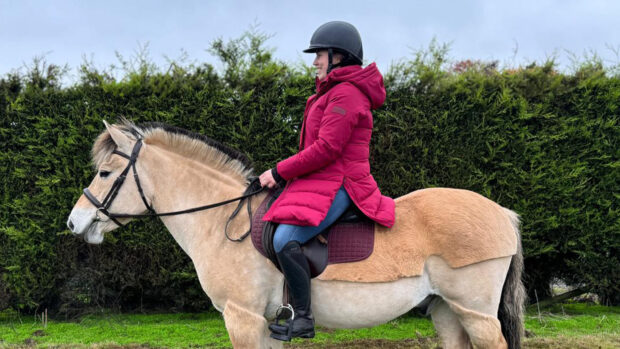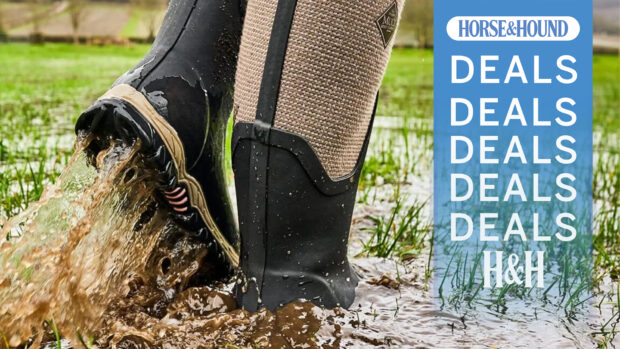Riding horses in the rain need not be unpleasant if you are well prepared with waterproof kit for both rider and horse, and appropriate aftercare
We may not look forward to riding in the rain, but you are probably a lot more bothered about getting wet than your horse is. If you live in England, where it rains roughly every other day, and avoid riding your horse when it’s wet, you’ll halve your potential time in the saddle. Your horse will lose out on fitness, but also on developing the proprioception that comes from learning how to adapt to different conditions underfoot, like when riding on wet ground. And if you don’t ride at home when it’s wet, what happens when it’s raining on competition day? Both you and the horse need to be ready for whatever the heavens have in store. Puddle practice? Tick. Just be aware that rain can turn the going slippery or deep, and create low visibility.
If possible, tack the horse up in the stable, both so that you don’t have to sit in a wet, slippery saddle and to protect the tack. It might be sensible to stay near home so that you can return quickly if the weather turns really nasty, and if strong winds or thunderstorms are in the forecast, it’s best not to venture out. But in everyday rain, once you’re wrapped up and in action, chances are both you and the horse will hardly notice it. Don’t forget that visibility is reduced in bad weather, so hi-viz kit for you as well as hi-viz for your horse is essential if you’re out and about.
And there are plenty of measures you can take to ensure you don’t end up soaked to the skin and miserable. As with any other sport, there is high-tech kit available to keep you and your horse dry. You will also need to protect your leather tack, particularly the saddle, from water damage.
Riding in the rain: the rider
Kit yourself out properly, and you might actually enjoy heading out into the elements. You’ll certainly feel smug when you’re back home with a cup of tea and dry toes. The most important attire for keeping dry is a decent rain jacket suitable for riding. It needs to be waterproof, appropriate for the season – a cosy jacket in winter, a light waterproof in summer – and then it’s up to you on the style. Do you prefer riding in a long jacket, such as Equetech’s trench coat, that covers your upper leg and much of the saddle, or does shorter suit you better for greater ease of movement, such as Weatherbeeta’s Tania?
Check out the labelling – “shower-resistant” or “splash-proof” aren’t ideal for a downpour, while the more technical materials such as Gore Tex with taped seams are designed to withstand more of a deluge. Then there’s the finish – you can opt for the lighter man-made fabrics, or a more traditional waxed or oiled jacket, which are heavier but seem to stand the test of time. Be aware that, like your horse rugs, all waterproof jackets will eventually need reproofing to retain their water-repellent properties.
Waterproof riding trousers – whether breeches or chaps – are a must for keeping your legs dry. Waterproof breeches with grippy seats or knee patches are handy for helping you keep secure in a slippery saddle. Depending on the time of year, you may want additional linings or extra protection from the wind. Again, check out whether the breeches are waterproof and offer complete protection or just water-resistant. Darker colours are definitely an advantage when the mud starts to fly. Full chaps, such as Horseware’s Rambo fleece-lined ones, are a good idea in wet weather, although there are some half-chaps designed for use in wintry conditions, such as the AK Winter Warmax insulated half-chaps.
Alternatively, long waterproof riding boots should help keep you warm, dry and cosy, while giving you the same sort of feel you would get from a normal riding boot as opposed to wellies.
Finally, don’t forget your fingers – wet, numb hands on slippery reins is a recipe for losing control. The best winter riding gloves will strike a balance of waterproof insulation and tactility so that your hands stay dry but allow you feel on the reins. Look for gloves with a good grip as this becomes even more important when the reins are wet.
Whatever the weather, always have a change of clothes at the yard or in your car, so you are ready for any eventuality.
Keeping the horse comfortable
If you keep the horse moving so that he doesn’t get cold, he should simply get wet and dry off as he would in the herd. However, a waterproof exercise sheet is a bonus for keeping the big muscle groups of the hindquarters and back dry and warm, especially for fully clipped horses. These are available in a range of styles, including high-viz. Whitaker’s ride-on rain sheet covers the horse quite comprehensively for those horses that hide from the elements, and also keeps the saddle dry.
Make sure you dry the horse off afterwards as you would if he was sweaty after a ride, and rug him appropriately. As soon as you’ve untacked, soak up any excess moisture by rubbing his coat with a towel and put a cooler rug on the horse – whether he is sweaty or rain-drenched – to help his body temperature to return to normal. The thickness of cooler will depend on the season. This will wick moisture from his skin and coat into the cooler, and prevent any wind from chilling him. Do not turn him out until he is dry and the correct temperature.
Protecting the tack after riding in the rain
Synthetic tack stands up better to a good soaking than leather, which will need some additional care if it gets drenched. Water can cause the leather to dry out and crack, or it can go mouldy if put away damp.
Some exercise sheets go on top of the saddle, protecting it from the rain. Or you can use a waterproof saddle cover, however test it out riding it at home first because some riders find them too slippery.
If your tack does get wet, don’t panic. As soon as you’ve settled the horse and dried off yourself, you need to attend to your leather kit. Don’t leave it until the following day. Remove any saddle cloths to dry and then wipe the leather with a cloth to get rid of any excess moisture. Use a good-quality leather cleaner to nourish the tack, being careful not to use much water, and then follow up with a tack conditioner, such as NAF’s leather balsam. Leave the leather to dry indoors, but not in direct sunlight or near a heater as this could leave the leather warped and liable to crack. A saddle may take more than 24hrs to dry completely. Store the saddle uncovered on a rack so that the air can circulate, helping to prevent mould spores forming. Once it is completely dry, treat again with a tack conditioner.
No excuses, now is the time to wrap up and embrace the elements!
You may also like to read…

10 of the best waterproof trousers to keep you warm and dry in the saddle this winter

Stay dry in the saddle with these waterproof winter breeches

12 pairs of gloves designed for winter riding

What to wear out hunting – for autumn hunting and season proper

Subscribe to Horse & Hound magazine today – and enjoy unlimited website access all year round
Horse & Hound magazine, out every Thursday, is packed with all the latest news and reports, as well as interviews, specials, nostalgia, vet and training advice. Find how you can enjoy the magazine delivered to your door every week, plus options to upgrade your subscription to access our online service that brings you breaking news and reports as well as other benefits.




